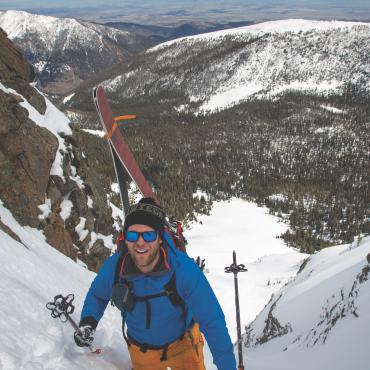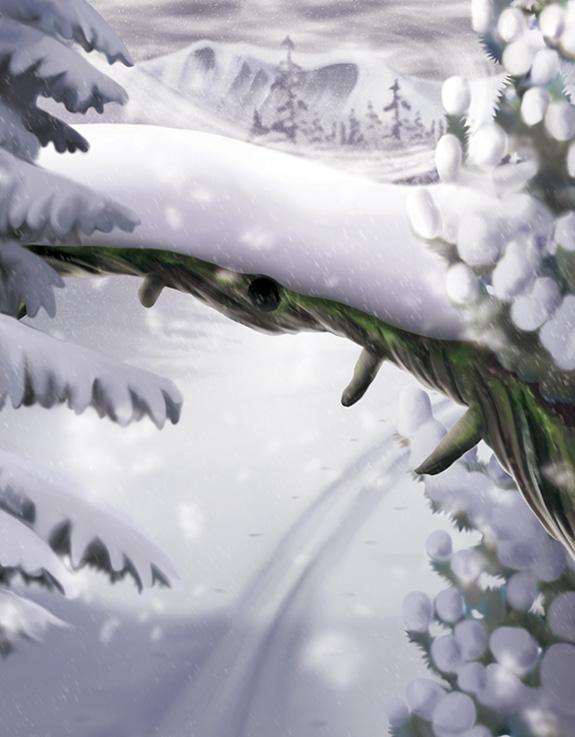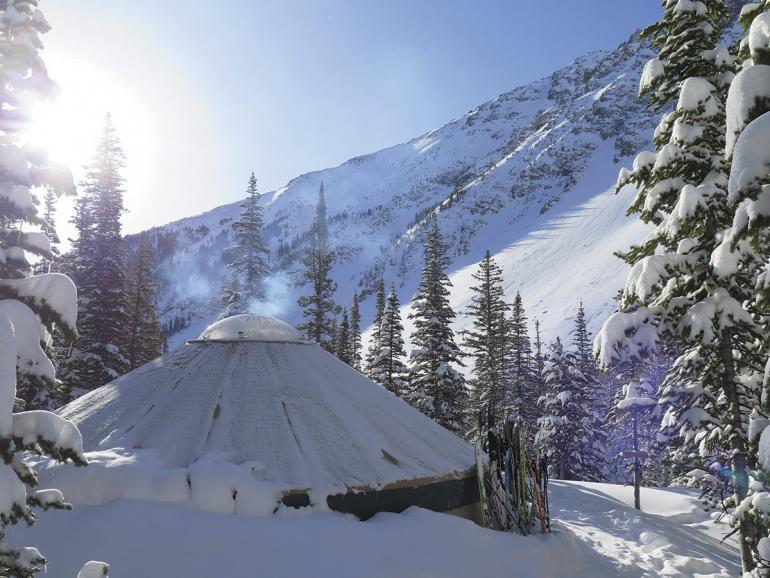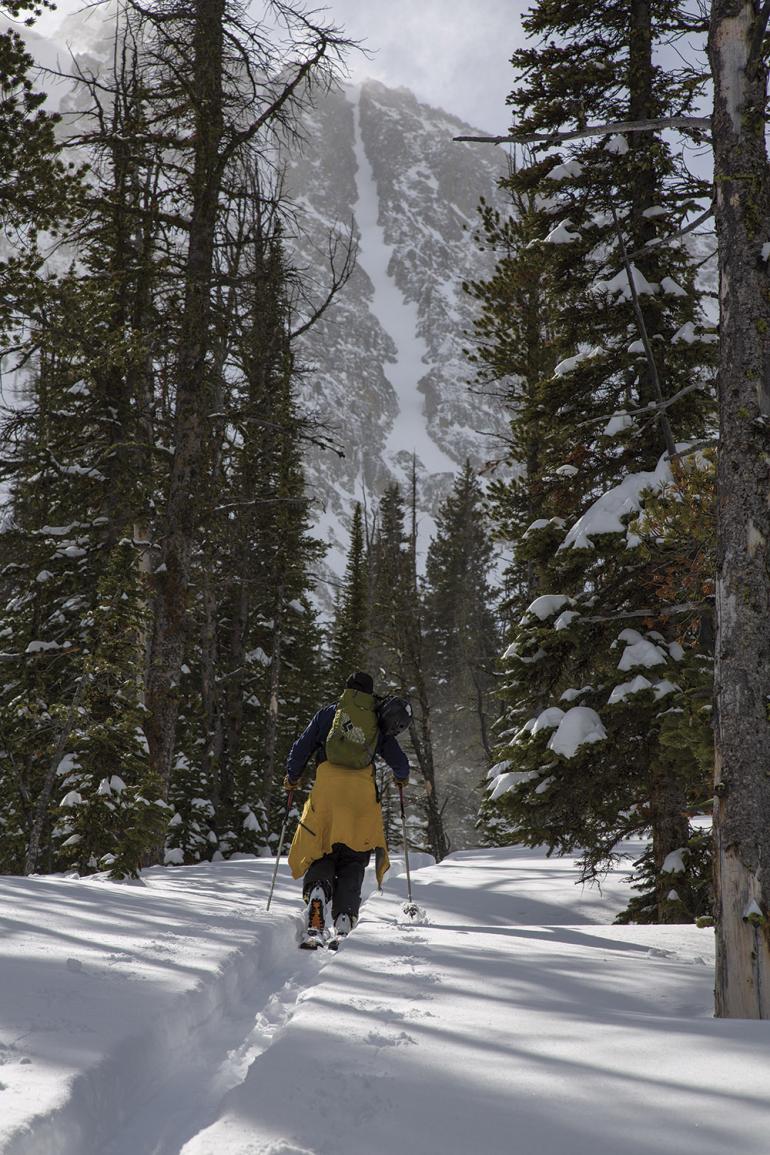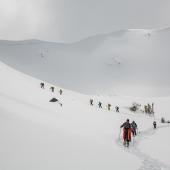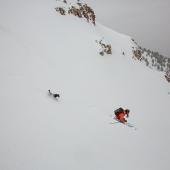The Tree in the Trail
Winter's standard-bearer.
There’s a tree I watch. It’s an ancient spruce, and it’s been dead for decades, stripped of branches and bleached a rich gray by weather and time. Vibrant streaks of contrasting black and ocher grain bleed from knots where branches once grew—if it were barn wood, it’d sell for five dollars a board foot. But this tree is located at about 8,400 feet, just below treeline and near the backcountry yurt I operate as a ski guide. Ski season runs from early December through June, which means I’m in these mountains for seven months a year, and pass this tree with every trip up and down. It has become a landmark, a timepiece, a calendar, and a friend. It has become the yardstick by which I measure winter.
Bright-green foliose lichen grows on the north side of the twisted trunk, and woodpeckers have excavated an impressive cavity about halfway up, now frequently occupied by chipmunks. At some point, probably during a fierce winter storm, it toppled downhill but hung up in the crotch of a sturdy whitebark pine. It would’ve been a sight to behold, that fall, as the spruce’s great roots ripped from the ground in slow, moaning defeat, clutching boulders the size of garbage cans amidst the woody, earthen tangle. It happened to fall over a steep section of singletrack trail—the trail I skin up several days a week all winter—forming a perfect arboreal arch. In the summer it’s about 10 feet off the ground; riders on horseback can pass under it easily. But in winter, everything changes.
In the pre-season, I ski beneath it on a skim-coat of snow, hardly aware of its presence save for a subconscious acknowledgement that one day, after years of leaning, it’ll likely fall at the very moment I pass (hey, I was raised Lutheran). The landscape is a lightly frosted version of its summer self—angular and hard, with sticks and snags and talus poking out at severe angles. Skiing is best reserved for grassy meadows and alpine gullies, but the transition to winter is underway.
With every storm, the snowpack grows deeper, and finally the season begins in earnest. Sometime in December, I always notice the tree as if for the first time—it surprises me. It’s markedly closer to eye level than just a few days earlier, it seems. The enormous, tentacled root ball is suddenly drifted over—just another snowy mound. On top of the log, a fresh cap of snow (that wasn’t there a couple of days earlier, I swear) displays each storm layer in perfect relief—the stratigraphy of the season—and its incremental growth is engaging. Each trip up the skintrack, I anticipate the tree and it’s mushrooming snowcap. I look ahead to gauge “how we’re doing,” and always find a satisfying symbol of the deepening winter.
The land slowly sheds its angularity; edges round; margins become undefined. Snow and wind smooth the terrain into sculpted curves. But the grand scale of the mountains is too large, and it’s difficult to see winter’s change as anything but a general whitening; more snow or less rock. There’s too much to take in—it’s difficult to see the forest for the trees. Except for one. At this tree, the change is apparent, and encouraging. It is the constant and the standard-bearer. Of course, there are other, similar indicators of the passage of winter.
There’s Sugar Bowl, a short but beloved ski run near the yurt that in the summer is a horrifying jumble of van-sized granite blocks. To see it then makes any idea of skiing there seem crazy. But it blows in deep and cold, and by December, the rocks have rounded off and the spaces between have inexplicably filled. By January or February, the boulders are mostly gone. The jumble is erased, and the slope is planar and smooth and perfect for relaxed powder turns. My guests have no idea of the chaos that lies just a few feet below—but the knowledge makes me appreciate each turn that much more. It’s a secret I share with the mountains.
The yurt itself is a yardstick. When it goes up in the crisp days of fall, the floor is more than two feet off the ground. The walls add another seven feet, and standing beside it, looking up at the edge of the roof, it seems impossible that snow could pile up so deep. But pile up it does. It starts slow, with the October storms that drop a few inches at a time. We step up to the deck, shovel the modest accumulation, and hope for more. We begin skiing, and even as we begin to enjoy good turns, at the end of the day we lean our skis against the yurt walls, and the tips don’t come close to reaching the roof. Then one day, I realize we aren’t stepping up to the deck anymore. After another storm or two, the shoveling becomes more difficult as we must lift the snow away, rather than push it off. And finally, I find myself cutting stairs in the snow, down to the door. In the deepest years, the yurt is completely buried, and we must dig a moat around the edge of the roof to give it room to shed. It amazes me every time, though I should be accustomed to it—but there is magic in snow that can conceal a building, small as it may be.
But snow doesn’t just fall uniformly, and fill in the dark spaces. In the alpine, we watch the lines change day by day as snow and wind and sun play on one another like strokes from a painter’s brush. And as the mountains fill and spread and strip and swale, there is a rhythm to these strokes. The mountains breathe. And by matching the rhythm and watching the rise and fall, we explore and ski and laugh. It is this process, of learning how to see the mountains breathe, that produces my greatest satisfaction—more than deep powder, or steep lines, or big days. We make a relationship with the place, like the one I have with the tree in the trail.
There comes a day, usually in late January or early February, when I try to duck under the tree and realize it’s no longer practical. Doing a limbo just to stay on the trail is silly. So the track shifts uphill, crossing over the mound where the enormous root ball would be, if it weren’t buried by several feet of snow. Now the tree is below our ski tips—a welcome perspective that signifies a winter gone right.
Inevitably though, when the pillow grows large enough, with a wall of snow balanced improbably on the narrow, convex trunk, temptation becomes too great and someone knocks it down. With an impetuous kick, they break it free, and the delicately corniced pillow falls with a thud. It may be irrational, but when this happens I can’t help but feel disappointed: why would anyone knock it down? There is only one reason: a desire to destroy something beautiful. I try not to think about human nature too much.
There is a silver lining, however. The broken pillow fills the remaining space under the tree, and by the next storm, the trunk is just a bump in the track. As I ski over it, I try to wrap my head around the idea that we’re striding along, high above the ground. Horses can walk in the space under our feet, I think. Every year, it’s unbelievable in the best way. In the way a child is delighted by something he can’t understand, I am delighted by imagining the lost world beneath our skis. In that moment, the winter is full and good and complete. Deep snow is the new reality, and what came before doesn’t matter. And the tree remains my yardstick, even below the surface, because the season is far from over.
This essay is reprinted from Elevation Outdoors magazine. Drew Pogge owns the Bell Lake Yurt, which is nestled high in the Tobacco Roots north of Ennis.

